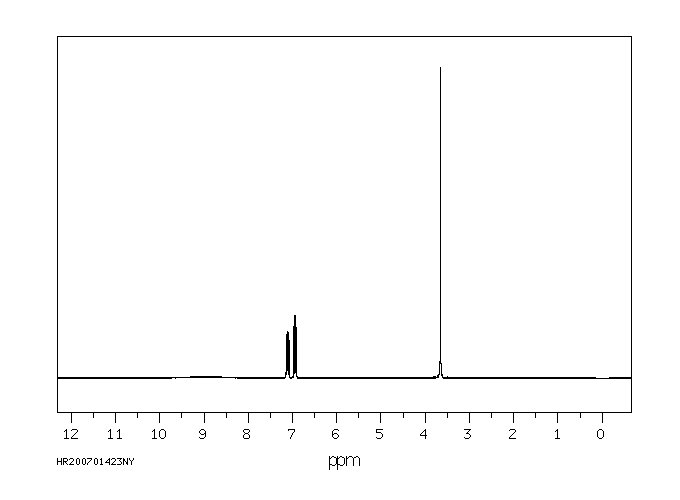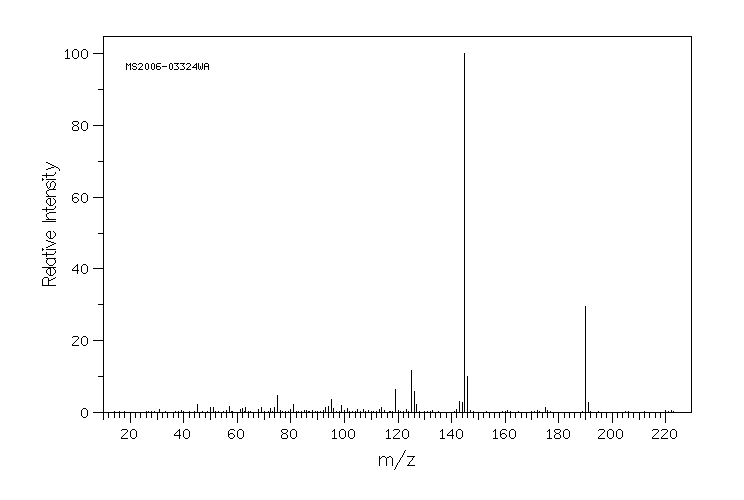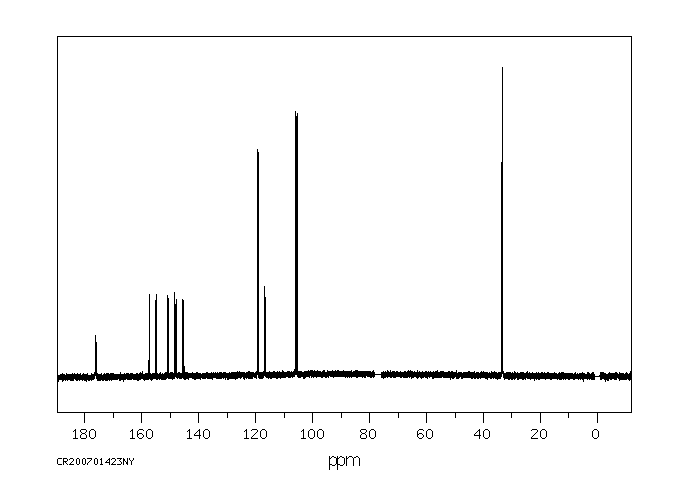2,4,5-三氟苯乙酸 | 209995-38-0
-
物化性质
-
计算性质
-
ADMET
-
安全信息
-
SDS
-
制备方法与用途
-
上下游信息
-
文献信息
-
表征谱图
-
同类化合物
-
相关功能分类
-
相关结构分类
物化性质
-
熔点:121-125 °C
-
沸点:255.0±35.0 °C(Predicted)
-
密度:1.468±0.06 g/cm3(Predicted)
-
溶解度:可溶于氯仿(少许)、DMSO(少许)、甲醇(少许)
-
稳定性/保质期:
避氧化物
计算性质
-
辛醇/水分配系数(LogP):1.7
-
重原子数:13
-
可旋转键数:2
-
环数:1.0
-
sp3杂化的碳原子比例:0.125
-
拓扑面积:37.3
-
氢给体数:1
-
氢受体数:5
安全信息
-
危险等级:IRRITANT
-
危险品标志:Xi
-
安全说明:S26,S39
-
危险类别码:R41,R37/38
-
WGK Germany:3
-
海关编码:2916399090
-
危险品运输编号:NONH for all modes of transport
-
危险标志:GHS05,GHS07
-
危险性描述:H315,H318,H335
-
危险性防范说明:P261,P280,P305 + P351 + P338
-
储存条件:保存方法:密封、阴凉、通风干燥处。
SDS
: 2,4,5-Trifluorophenylacetic acid
化学品俗名或商品名
1.2 鉴别的其他方法
无数据资料
1.3 有关的确定了的物质或混合物的用途和建议不适合的用途
仅供科研用途,不作为药物、家庭备用药或其它用途。
模块 2. 危险性概述
2.1 GHS分类
皮肤刺激 (类别2)
严重的眼损伤 (类别1)
特异性靶器官系统毒性(一次接触) (类别3)
2.2 GHS 标记要素,包括预防性的陈述
危害类型象形图
信号词 危险
危险申明
H315 造成皮肤刺激。
H318 造成严重眼损伤。
H335 可能引起呼吸道刺激。
警告申明
预防
P261 避免吸入粉尘/ 烟/ 气体/ 烟雾/ 蒸汽/ 喷雾。
P264 操作后彻底清洁皮肤。
P271 只能在室外或通风良好之处使用。
P280 穿戴防护手套/ 眼保护罩/ 面部保护罩。
措施
P302 + P352 如果在皮肤上: 用大量肥皂和水淋洗。
P304 + P340 如果吸入: 将患者移到新鲜空气处休息,并保持呼吸舒畅的姿势。
P305 + P351 + P338 如进入眼睛:用水小心清洗几分钟。如戴隐形眼镜并可方便地取出,取出
隐形眼镜。继续冲洗。
P310 立即呼救解毒中心或医生。
P321 具体治疗(见本标签上提供的急救指导)。
P332 + P313 如发生皮肤刺激:求医/ 就诊。
P362 脱掉沾染的衣服,清洗后方可重新使用。
储存
P403 + P233 存放于通风良的地方。 保持容器密闭。
P405 存放处须加锁。
处理
P501 将内容物/ 容器处理到得到批准的废物处理厂。
2.3 其它危害物 - 无
模块 3. 成分/组成信息
3.1 物 质
: C8H5F3O2
分子式
: 190.12 g/mol
分子量
成分 浓度
2,4,5-Trifluorophenylacetic acid
-
化学文摘编号(CAS No.) 209995-38-0
模块 4. 急救措施
4.1 必要的急救措施描述
一般的建议
请教医生。 出示此安全技术说明书给到现场的医生看。
如果吸入
如果吸入,请将患者移到新鲜空气处。 如果停止了呼吸,给于人工呼吸。 请教医生。
在皮肤接触的情况下
用肥皂和大量的水冲洗。 请教医生。
在眼睛接触的情况下
用大量水彻底冲洗至少15分钟并请教医生。
如果误服
切勿给失去知觉者从嘴里喂食任何东西。 用水漱口。 请教医生。
4.2 最重要的症状和影响,急性的和滞后的
据我们所知,此化学,物理和毒性性质尚未经完整的研究。
4.3 及时的医疗处理和所需的特殊处理的说明和指示
无数据资料
模块 5. 消防措施
5.1 灭火介质
灭火方法及灭火剂
用水雾,耐醇泡沫,干粉或二氧化碳灭火。
5.2 源于此物质或混合物的特别的危害
碳氧化物, 氟化氢
5.3 救火人员的预防
如必要的话,戴自给式呼吸器去救火。
5.4 进一步的信息
无数据资料
模块 6. 泄露应急处理
6.1 人员的预防,防护设备和紧急处理程序
使用个人防护设备。 防止粉尘的生成。 防止吸入蒸汽、气雾或气体。 保证充分的通风。
将人员撤离到安全区域。 避免吸入粉尘。
6.2 环境预防措施
不要让产物进入下水道。
6.3 抑制和清除溢出物的方法和材料
收集、处理泄漏物,不要产生灰尘。 扫掉和铲掉。 存放在合适的封闭的处理容器内。
6.4 参考其他部分
丢弃处理请参阅第13节。
模块 7. 操作处置与储存
7.1 安全操作的注意事项
避免接触皮肤和眼睛。 防止粉尘和气溶胶生成。
在有粉尘生成的地方,提供合适的排风设备。一般性的防火保护措施。
7.2 安全储存的条件,包括任何不兼容性
贮存在阴凉处。 容器保持紧闭,储存在干燥通风处。
7.3 特定用途
无数据资料
模块 8. 接触控制/个体防护
8.1 控制参数
最高容许浓度
没有已知的国家规定的暴露极限。
8.2 暴露控制
适当的技术控制
根据工业卫生和安全使用规则来操作。 休息以前和工作结束时洗手。
人身保护设备
眼/面保护
面罩與安全眼鏡请使用经官方标准如NIOSH (美国) 或 EN 166(欧盟) 检测与批准的设备防护眼部。
皮肤保护
戴手套取 手套在使用前必须受检查。
请使用合适的方法脱除手套(不要接触手套外部表面),避免任何皮肤部位接触此产品.
使用后请将被污染过的手套根据相关法律法规和有效的实验室规章程序谨慎处理. 请清洗并吹干双手
所选择的保护手套必须符合EU的89/686/EEC规定和从它衍生出来的EN 376标准。
身体保护
全套防化学试剂工作服, 防护设备的类型必须根据特定工作场所中的危险物的浓度和含量来选择。
呼吸系统防护
如危险性评测显示需要使用空气净化的防毒面具,请使用全面罩式多功能微粒防毒面具N100型(US
)或P3型(EN
143)防毒面具筒作为工程控制的候补。如果防毒面具是保护的唯一方式,则使用全面罩式送风防毒
面具。 呼吸器使用经过测试并通过政府标准如NIOSH(US)或CEN(EU)的呼吸器和零件。
模块 9. 理化特性
9.1 基本的理化特性的信息
a) 外观与性状
形状: 固体
b) 气味
无数据资料
c) 气味临界值
无数据资料
d) pH值
无数据资料
e) 熔点/凝固点
熔点/熔点范围: 121 - 125 °C
f) 起始沸点和沸程
无数据资料
g) 闪点
无数据资料
h) 蒸发速率
无数据资料
i) 可燃性(固体,气体)
无数据资料
j) 高的/低的燃烧性或爆炸性限度 无数据资料
k) 蒸气压
无数据资料
l) 相对蒸气密度
无数据资料
m) 相对密度
无数据资料
n) 水溶性
无数据资料
o) 辛醇/水分配系数的对数值
辛醇--水的分配系数的对数值: 1.851
p) 自燃温度
无数据资料
q) 分解温度
无数据资料
r) 粘度
无数据资料
模块 10. 稳定性和反应活性
10.1 反应性
无数据资料
10.2 化学稳定性
无数据资料
10.3 危险反应的可能性
无数据资料
10.4 避免接触的条件
无数据资料
10.5 不兼容的材料
强氧化剂
10.6 危险的分解产物
其它分解产物 - 无数据资料
模块 11. 毒理学资料
11.1 毒理学影响的信息
急性毒性
无数据资料
皮肤腐蚀/刺激
严重眼损伤 / 眼刺激
无数据资料
呼吸道或皮肤过敏
无数据资料
生殖细胞诱变
无数据资料
致癌性
IARC:
此产品中没有大于或等于 0。1%含量的组分被 IARC鉴别为可能的或肯定的人类致癌物。
生殖毒性
无数据资料
特异性靶器官系统毒性(一次接触)
吸入 - 可能引起呼吸道刺激。
特异性靶器官系统毒性(反复接触)
无数据资料
吸入危险
无数据资料
潜在的健康影响
吸入 吸入可能有害。 引起呼吸道刺激。
摄入 如服入是有害的。
皮肤 如果通过皮肤吸收可能是有害的。 造成皮肤刺激。
眼睛 引起眼睛烧伤。
接触后的征兆和症状
据我们所知,此化学,物理和毒性性质尚未经完整的研究。
附加说明
化学物质毒性作用登记: 无数据资料
模块 12. 生态学资料
12.1 毒性
无数据资料
12.2 持久存留性和降解性
无数据资料
12.3 生物积累的潜在可能性
无数据资料
12.4 土壤中的迁移
无数据资料
12.5 PBT 和 vPvB的结果评价
无数据资料
12.6 其它不利的影响
无数据资料
模块 13. 废弃处置
13.1 废物处理方法
产品
将剩余的和未回收的溶液交给处理公司。 联系专业的拥有废弃物处理执照的机构来处理此物质。
与易燃溶剂相溶或者相混合,在备有燃烧后处理和洗刷作用的化学焚化炉中燃烧
污染了的包装物
作为未用过的产品弃置。
模块 14. 运输信息
14.1 UN编号
欧洲陆运危规: - 国际海运危规: - 国际空运危规: -
14.2 联合国(UN)规定的名称
欧洲陆运危规: 无危险货物
国际海运危规: 无危险货物
国际空运危规: 无危险货物
14.3 运输危险类别
欧洲陆运危规: - 国际海运危规: - 国际空运危规: -
14.4 包裹组
欧洲陆运危规: - 国际海运危规: - 国际空运危规: -
14.5 环境危险
欧洲陆运危规: 否 国际海运危规 海运污染物: 否 国际空运危规: 否
14.6 对使用者的特别预防
无数据资料
模块 15 - 法规信息
N/A
模块16 - 其他信息
N/A
制备方法与用途
2,4,5-三氟苯乙酸是一种白色固体,用于合成治疗II型糖尿病的新药sitagliptin的中间体。sitagliptin是默克公司最新上市的首个DPP-IV抑制剂,其在治疗II型糖尿病方面疗效好、副作用小、安全性和耐受性佳,市场前景广阔。
制备 步骤1:2,4,5-三氟苄基氯化镁的制备在250毫升装有三个颈管的烧瓶中,进行氮气保护,并在室温下依次加入四氢呋喃120毫升和7.2克(0.45摩尔)的镁屑。搅拌过程中,缓慢滴加1,2-二溴乙烷0.56克(0.003摩尔),待温度升至30℃后,再缓慢滴加2,4,5-三氟苄氯9克(0.05摩尔),保持溶液微沸。随后,在温度升至60℃时继续滴加2,4,5-三氟苄氯45克(0.25摩尔),并维持反应约5-6小时,直至镁屑基本消失,从而制得2,4,5-三氟苄基氯化镁。
步骤2:2,4,5-三氟苯乙酸的制备在氮气保护条件下,将步骤1所得含有2,4,5-三氟苄基氯化镁61克的反应液中分批加入干冰10克×3次。每隔3小时加入一次,控制反应温度在0℃至15℃之间。待干冰完全加入后,在0℃至28℃下继续反应3-4小时。
然后将上述反应液缓慢滴入到冰水混合物中的2摩尔/升HCl溶液中,并用乙酸乙酯进行三次萃取,每次使用30克。合并有机相并使用40克饱和食盐水洗涤两次后,通过无水硫酸钠干燥、过滤、蒸发滤液得粗制的2,4,5-三氟苯乙酸54克。经甲醇140毫升重结晶处理后,最终得到纯净的2,4,5-三氟苯乙酸50.7克。
上下游信息
-
上游原料
中文名称 英文名称 CAS号 化学式 分子量 2,4,5-三氟苯乙酸甲酯 methyl 2-(2,4,5-trifluorophenyl)acetate 1036273-20-7 C9H7F3O2 204.149 2,4,5-三氟苯乙酸乙酯 ethyl 2-(2,4,5-trifluorophenyl)acetate 1256470-41-3 C10H9F3O2 218.175 2,4,5-三氟苯乙醇 2-(2,4,5-trifluorophenyl)ethanol 883267-70-7 C8H7F3O 176.138 2-(2,4,5-三氟苯基)乙醛 2-(2,4,5-trifluorophenyl)acetaldehyde 111991-20-9 C8H5F3O 174.122 2,4,5-三氟扁桃酸 2,4,5-trifluoromandelic acid 375369-29-2 C8H5F3O3 206.121 —— (2,4,5-trifluorophenyl)oxoacetic acid 1702443-94-4 C8H3F3O3 204.105 2-(2,4,5-三氟苯基)-2-氯乙酸 2-(2,4,5-trifluorophenyl)-2-chloroacetic acid 1036273-14-9 C8H4ClF3O2 224.567 3-(2,4,5-三氟苯基)-1-丙烯 1-allyl-2,4,5-trifluorobenzene 680993-47-9 C9H7F3 172.15 2,4,5-三氟苯乙腈 2-(2,4,5-trifluorophenyl)acetonitrile 220141-74-2 C8H4F3N 171.122 —— 2,4,5-tri-fluorobenzoylformic acid ethyl ester —— C10H7F3O3 232.159 2-(2,4,5-三氟苯基)丙二酸二乙酯 1,3-diethyl 2-(2,4,5-trifluorophenyl)malonate 262609-08-5 C13H13F3O4 290.239 —— 2,4,5-trifluorobenzene-1-carbonyl cyanide 2091697-40-2 C8H2F3NO 185.105 2,4,5-三氟甲苯 2,4,5-trifluorotoluene 887267-34-7 C7H5F3 146.112 2-氯-1-(2,4,5-三氟苯基)乙酮 2-chloro-1-(2,4,5-trifluorophenyl)ethanone 129604-31-5 C8H4ClF3O 208.567 - 1
- 2
-
下游产品
中文名称 英文名称 CAS号 化学式 分子量 2,4,5-三氟苯乙酸甲酯 methyl 2-(2,4,5-trifluorophenyl)acetate 1036273-20-7 C9H7F3O2 204.149 2,4,5-三氟苯乙酸乙酯 ethyl 2-(2,4,5-trifluorophenyl)acetate 1256470-41-3 C10H9F3O2 218.175 2,4,5-三氟苯乙醇 2-(2,4,5-trifluorophenyl)ethanol 883267-70-7 C8H7F3O 176.138 2-(2,4,5-三氟苯基)乙醛 2-(2,4,5-trifluorophenyl)acetaldehyde 111991-20-9 C8H5F3O 174.122 —— α-bromo-(2,4,5-trifluorophenyl)acetic acid 251366-49-1 C8H4BrF3O2 269.018 —— 1,3-Bis-(2,4,5-trifluoro-phenyl)-propan-2-one 881995-71-7 C15H8F6O 318.218 —— 2-(2,4,5-trifluorophenyl)acetohydrazide —— C8H7F3N2O 204.152 西他列汀杂质26 2,4,5-trifluorophenylacetoacetic acid 1256815-03-8 C10H7F3O3 232.159 (3S)-2’,4’,5’-三氟-3-羟基苯丁酸 4-(2,4,5-trifluorophenyl)-3(S)-hydroxybutanoic acid 868071-17-4 C10H9F3O3 234.175 3-氧代-4-(2,4,5-三氟苯基)丁酸甲酯 methyl 4-(2,4,5-trifluorophenyl)acetoacetate 769195-26-8 C11H9F3O3 246.186 —— (R)-methyl 3-hydroxy-4-(2,4,5-trifluorophenyl)butanoate 1138326-05-2 C11H11F3O3 248.202 —— 3(S)-4-(2,4,5-trifluorophenyl)-3-hydroxybenzenebutanoic acid methyl ester 868071-16-3 C11H11F3O3 248.202 3-氧代-4-(2,4,5-三氟苯基)丁酸甲酯 ethyl 3-oxo-4-(2,4,5-trifluorophenyl)butanoate 1151240-88-8 C12H11F3O3 260.213 (R)-3-氨基-4-(2,4,5-三氟苯基)丁酸 (R)-3-amino-4-(2,4,5-trifluorophenyl)butyric acid 936630-57-8 C10H10F3NO2 233.19 - 1
- 2
反应信息
-
作为反应物:描述:2,4,5-三氟苯乙酸 在 chloro(1,5-cyclooctadiene)rhodium(I) dimer 乙酸铵 、 4-二甲氨基吡啶 、 lithium hydroxide 、 氢气 、 三甲基乙酰氯 、 N,N-二异丙基乙胺 作用下, 以 四氢呋喃 、 甲醇 、 二氯甲烷 、 2,2,2-三氟乙醇 、 甲苯 、 乙腈 为溶剂, 20.0~50.0 ℃ 、689.49 kPa 条件下, 反应 59.0h, 生成 Boc-(R)-3-氨基-4-(2,4,5-三氟苯基)丁酸参考文献:名称:作为二肽基肽酶IV(DPP-IV)抑制剂的含β-氨酰基的环状肼衍生物的合成,生物学评估和结构测定。摘要:二肽基肽酶IV(DPP-IV)抑制剂已被证明是治疗2型糖尿病的有效方法。合成了一系列含β-氨基酰基的环状肼衍生物,并作为DPP-IV抑制剂进行了评估。该系列的一个成员(R)-3-氨基-1-(2-苯甲酰基-1,2-二氮杂-1-基)-4-(2,4,5-三氟苯基)丁-1-(10f )在小鼠模型中显示出强大的体外活性,良好的选择性和体内功效。另外,化合物10f的结合模式通过X射线晶体学确定。DOI:10.1016/j.bmcl.2007.01.111
-
作为产物:参考文献:名称:2,4,5-三氟苯乙酸的制备方法摘要:本发明公开了一种2,4,5‑三氟苯乙酸的制备方法,属于化学药物中间体制备方法技术领域,利用2,4‑二氯氟苯为原料,经硝化、氟化、氯代、偶联和水解反应制备2,4,5‑三氟苯乙酸。本发明方法,采用的原料相对廉价易得,工艺路线成熟,操作简单,收率较高,具有较高的工业化价值。公开号:CN109400459B
文献信息
-
Pentafluorophenyl Esters: Highly Chemoselective Ketyl Precursors for the Synthesis of α,α-Dideuterio Alcohols Using SmI<sub>2</sub> and D<sub>2</sub>O as a Deuterium Source作者:Hengzhao Li、Yuxia Hou、Chengwei Liu、Zemin Lai、Lei Ning、Roman Szostak、Michal Szostak、Jie AnDOI:10.1021/acs.orglett.9b04383日期:2020.2.21We report the first highly chemoselective synthesis of α,α-dideuterio alcohols with exquisite incorporation of deuterium (>98% [D2]) using pentafluorophenyl esters as ketyl radical precursors, SmI2 as a mild reducing agent, and D2O as the deuterium source. This system tolerates a variety of functional groups, offering rapid entry to valuable α,α-dideuterated alcohol building blocks. More generally
-
PYRIDIN-3-YL ACETIC ACID DERIVATIVES AS INHIBITORS OF HUMAN IMMUNODEFICIENCY VIRUS REPLICATION申请人:Bristol-Myers Squibb Company公开号:US20150232463A1公开(公告)日:2015-08-20The disclosure generally relates to compounds of formula I, II, III and IV, including compositions and methods for treating human immunodeficiency virus (HIV) infection. The disclosure provides novel inhibitors of HIV, pharmaceutical compositions containing such compounds, and methods for using these compounds in the treatment of HIV infection.该披露通常涉及公式I、II、III和IV的化合物,包括用于治疗人类免疫缺陷病毒(HIV)感染的组合物和方法。该披露提供了HIV的新型抑制剂,包含这些化合物的药物组合物,以及在治疗HIV感染中使用这些化合物的方法。
-
Synthesis and Bio-Evaluation of Natural Butenolides-Acrylate Conjugates作者:Longzhu Bao、Shuangshuang Wang、Di Song、Jingjing Wang、Xiufang Cao、Shaoyong KeDOI:10.3390/molecules24071304日期:——
A series of novel 3-aryl-4-hydroxy-2(5H) furanone-acrylate hybrids were designed and synthesized based on the natural butenolides and acrylates scaffolds. The structures of the prepared compounds were characterized by 1H-NMR, 13C-NMR and electrospray ionization mass spectrometry (ESI-MS), and the bioactivity of the target compounds against twelve phytopathogenic fungi was investigated. The preliminary in vitro antifungal activity screening showed that most of the target compounds had moderate inhibition on various pathogenic fungi at the concentration of 100 mg·L−1, and presented broad-spectrum antifungal activities. Further studies also indicated that compounds 7e and 7k still showed some inhibitory activity against Pestallozzia theae, Sclerotinia sclerotiorum and Gibberella zeae on rape plants at lower concentrations, which could be optimized as a secondary lead for further research.
-
西他列汀中间体2,4,5-三氟苯乙酸的合成方法
-
Stereodivergent Carbon–Carbon Bond Formation between Iminium and Enolate Intermediates by Synergistic Organocatalysis作者:Byungjun Kim、Yongjae Kim、Sarah Yunmi LeeDOI:10.1021/jacs.0c11077日期:2021.1.13chiral Lewis base. This reaction proceeds through a synergistic catalytic cycle which consists of one cycle leading to a chiral iminium electrophile and a second cycle generating a nucleophilic chiral enolate for the construction of a carbon-carbon bond. By varying the combinations of catalyst enantiomers, all four stereoisomers of the products with two vicinal stereocenters are accessible with high
表征谱图
-
氢谱1HNMR
-
质谱MS
-
碳谱13CNMR
-
红外IR
-
拉曼Raman
-
峰位数据
-
峰位匹配
-
表征信息










